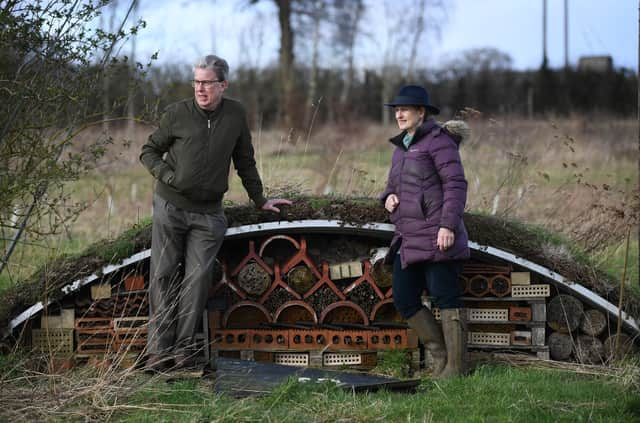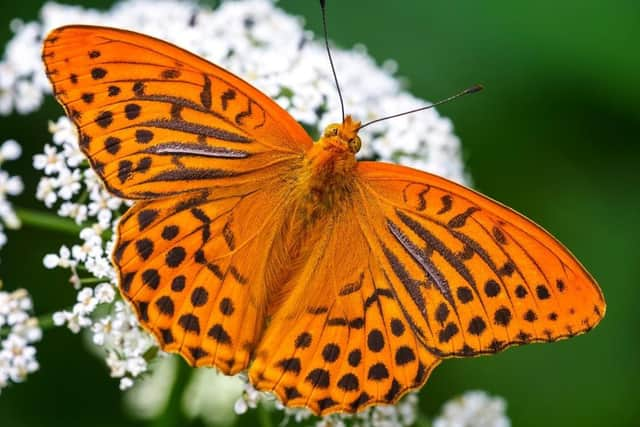How Yorkshire volunteers are fighting back against decline in butterfly numbers


The natural historian and broadcaster David Attenborough once described butterflies as a ‘litmus test’ of the health of our countryside so the findings of Butterfly Conservation’s last ‘State of the Nation’ report should concern us all. Published every five years or so, it cited evidence of the serious, long-term and ongoing decline of the UK’s butterflies since 1976.
At a regional level, Butterfly Conservation Yorkshire is closely monitoring butterfly numbers and working with landowners to restore lost habitat. The good news is that we can all play our part by encouraging butterflies into our gardens and onto our land.
Advertisement
Hide AdAdvertisement
Hide AdNick Hall, of Butterfly Conservation Yorkshire, says: “The best advice I can offer is for people to lock up their lawn mower. Leave wild areas of your garden if you can to provide butterflies with the nectar-rich food plants that they need. Often gardens are not good places for nectar, but just leaving an area of lawn to grow longer will make a real difference. If you’re feeling bold, you could sow a meadow seed mix in your garden or, if you’re feeling really bold, you could turn the soil upside down to expose the less fertile soil underneath, which will allow the type of plants that butterflies love to return.”


As well as monitoring the type and number of butterflies that we have here in Yorkshire, Nick and his fellow volunteers are working with landowners to develop wood-meadow habitats, which are one of the most important ecosystems for butterflies but also hugely beneficial to countless other species.
Widespread throughout Europe prior to and during the medieval period, this all-important habitat has largely disappeared. It was found across the UK in the days when it was largely covered in woodland.
Nick explains: “We often forget that we are a forest people; we just happen to have chopped it all down! When the nation was wild wood, there were spaces in the canopy, it wasn’t completely closed. This combination of light, dark and shade was so good for so many species.
Advertisement
Hide AdAdvertisement
Hide Ad“It’s no coincidence that the Pearl Bordered Fritillary butterfly was once known as the Woodsman’s Friend. So much life happens on the edge of woodland; a woodland that is closed over is not much better for butterflies than a farmer’s field. Farmland is a desert, except at its edges, where hedgerows connect with other hedgerows. Every county should have wood meadows to bring people closer to nature. They really help people to connect with butterflies and make them relevant.”
One of the best examples here in Yorkshire is Three Hagges Wood-Meadow near Riccall, just south of York, which is part of the Escrick Park Estate. The land was farmed until 2012 but Rosalind Forbes Adams, whose family have owned it for 350 years, has worked with a team of experts, many of them volunteers, to transform it into a 10-hectare, wood-meadow habitat. Between 2012 and 2013, around 10,000 native trees and shrubs were planted there. A native meadow seed mix collected from the nearby Derwent Ings was sown and the Hebridean sheep that graze the land for several months of the year helped to ‘tread’ this in.
Paths are mown through the site, creating what Nick refers to as grassy ‘rides’. These areas of open space on the edge of the woodland are where butterflies and other species thrive. Less than eight years since the last crop of barley was harvested from the former arable field, Nick describes the site as “a blaze of flowers and buzz of insects”. No less than 24 different butterfly species have been recorded there, including Brimstones, which Nick describes as the ‘harbingers of spring’ and are said to have put the ‘butter’ into the word butterfly because of their pale yellow colour.
You can also see Meadow Browns, Common Blues, Small Coppers and Marbled Whites at the site, which is open for members of the public to visit all year round and also hosts educational trips for schools. The development of Three Hagges Wood-Meadow has undoubtedly been a labour of love for Rosalind Forbes Adams and she’s a trustee of the Wood Meadow Trust, which was formed in 2013 to manage the site. Rosalind explains: “We had two key objectives when making the wood-meadow; creating and managing the site for the benefit of nature and the recovery of biodiversity, and also education. We’re very lucky to have a fantastic team of people, many of them volunteers, who monitor and record the butterflies, mammals, snakes, bats, moths and the botany we have here. We believe in open data, sharing the information we gather with anyone who is interested. On average, each new plant species will bring four of five different species of wildlife to the site, but for some plants that’s as many as 150.”
Advertisement
Hide AdAdvertisement
Hide AdAlthough butterflies are undoubtedly facing tough times, there are exceptions to the rule. Some species are appearing in larger numbers or moving further north due to climate change, and the brownfield sites created by the demise of some of Yorkshire’s coalfields and industrial sites has thrown certain species an unlikely lifeline. Nick reveals that the Dingy Skipper, which is in severe decline, has returned to the Selby area after an absence of 10 years, having made its home on the former North Selby Mine site, where the bare rock face is gradually reverting back to soil. “It’s the open mosaic at the rock edge that they like. The water’s edge, the woodland edge, the rock edge – the edge is always where diversity is.”
Two years ago, the Silver Washed Fritillary returned to Yorkshire for the first time in a century and there’s now a breeding population at Bishopwood, near Selby.
Nick says: “It was something I had never expected to see in my lifetime but walking in Bishopwood on June 30, 2018, there had been a hatch of Commas. However, something larger caught my eye and there on the pathway was a very fresh male Silver Washed Fritillary. Was this a lone wanderer? My question was answered a week later as more appeared and spread through the forest, along with several females. I discovered that more singletons had been seen in woodland on the Bramham Park Estate, just eight miles to the west. That July, when escorting a lost dog walker around firemen dousing a forest fire, we emerged in a glade that was new to me.
“Seeing six insects together made me sure that we’d stumbled upon the centre of the colony. I kept asking myself why they were here in such numbers and then realised that it must be for the violets. I set about mapping where in the wood violets grew and realised that the insects were only interested in flying sunny glades with violets nearby, completely ignoring the rest of the wood.”
Advertisement
Hide AdAdvertisement
Hide AdThe long-term future of the UK’s butterflies hangs in the balance, but Nick, Rosalind and their fellow volunteers are working hard to give them a foothold here in Yorkshire.
Best places in Yorkshire to see butterflies
Nick Hall says there are multiple places across the region to see butterflies – with the timing of visits key to making the most of trips.
He says the best places include Brockadale Nature Reserve, near Pontefract, from May to August, Bishop Wood, near Selby, in late July, Three Hagges Wood-Meadow, near Riccall, and Ledsham Bank Nature Reserve.
He also recommends Ellerburn Bank Nature Reserve, near Dalby Forest, Pickering, from May to August and the Fen Bog Nature Reserve, near Goathland in the North York Moors National Park, in July.
Also on his list is Fordon Chalk Bank, near Filey.
For more information, visit www.yorkshirebutterflies.org.uk.